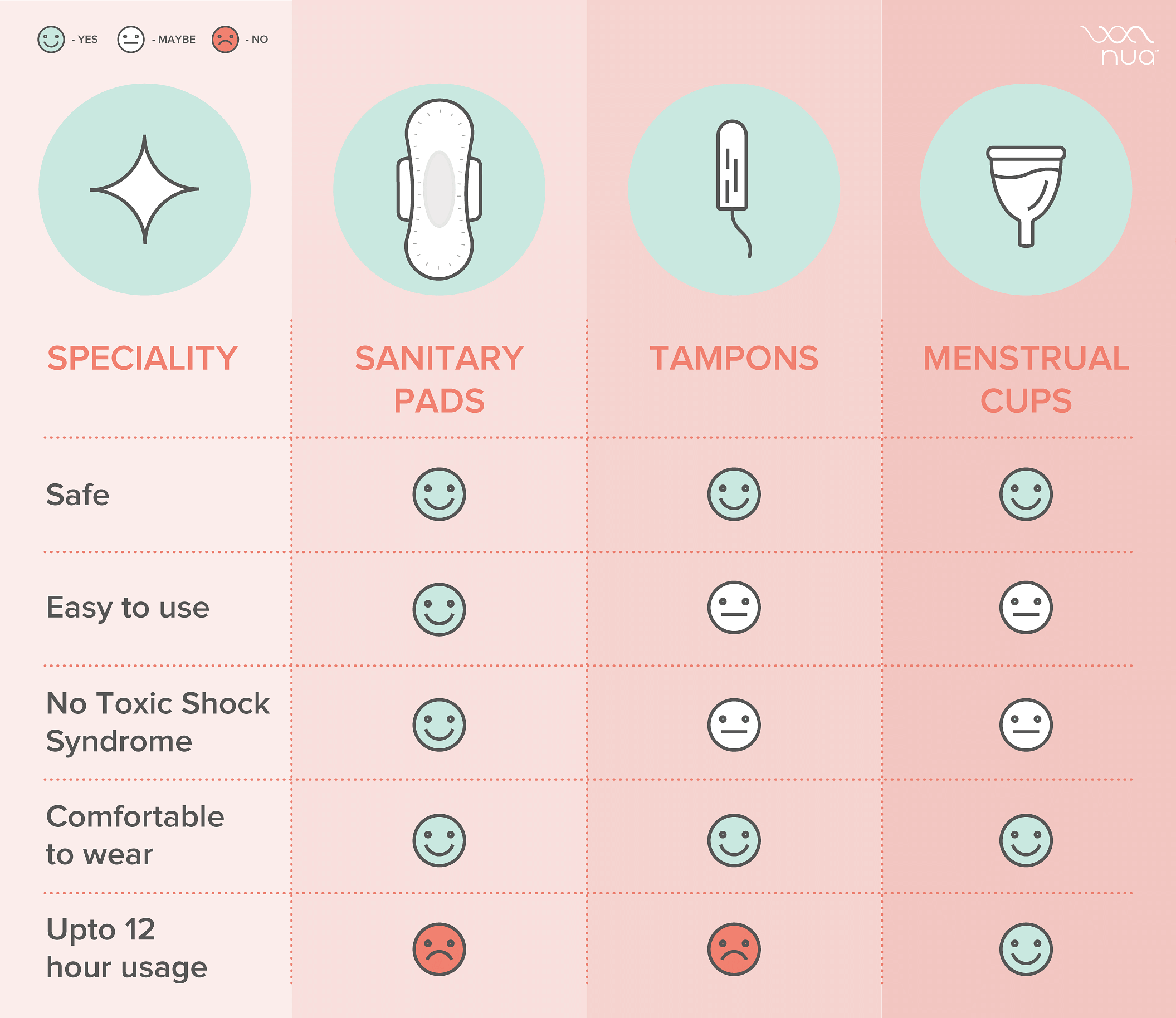The use of safe menstrual hygiene products is an integral part of women’s wellness. In the current era, we have choices of different menstrual management tools or products such as a sanitary pad, tampon and menstrual cup.
Depending on personal preferences, affordability, sustainability, disposal, and local access, you can use any of these period management products. Before you make a decision, here is what you need to know about all three.
Sanitary Pad
What is it?
It is a rectangle-shaped absorbent material which is attached inside of a girl’s underwear to catch menstrual blood. It is also called a menstrual cloth or sanitary napkin.
Types of Sanitary Pads
- Menstrual Cloth – It is made of pure cotton. These are reusable after washing them post each use and worn externally to the body, in underwear or tied to the waist.
- Reusable Pads – They are made from a variety of natural or synthetic materials and available online or health stores. They are held in place using a snap-on feature. They are environment friendly and can be used for upto 1 year with proper care.
- Disposable Pads – These pads have a layered design made of blends of plastics, rayon and cotton. Pads have wings to prevent leakage and keep the pad more securely in place. Pads come in various sizes, absorbencies and materials. Different types and sizes available in the market from normal to XXL.
How to use them?
Pads are either tied around the waist or stuck to the inner gusset of the underwear. Some pads have wings at the sides that are to be attached around your underwear to prevent leakage and give a secured grip. One needs to change their pads 3-4 times a day. One pad can be used for a maximum of 6-8 hours.
Advantages of Sanitary pads
They are considered reliable, hygienic, comfortable and easy to use (especially in contexts with limited privacy). They are easily available and are affordable. The need for frequent changing prevents infection and stops odour.
Disadvantages of Sanitary pads
As pads are disposed of after one use, they create large quantities of litter, accumulate in landfills, and block sanitation systems. An appropriate waste-management chain must be in place to combat adverse effects on the environment. Occasionally it can give rise to rashes and cannot be used during certain physical activities like water sports.
Tampon
What is it?
It is made of compressed absorbent material in the form of a small pellet which is inserted in the vagina to absorb menstrual blood. Tampons are available in different sizes and absorbances for heavier and lighter periods.
How to use or insert a tampon?
A tampon has a small about 1.5 to 2 cm stick-like pellet which goes in the lower 1/3 rd of the vagina. The outer end of the tampon has a string which lies outside vagina. It’s used to remove the tampon from vagina by a gentle tug. Few of them come with an applicator which can be used for insertion in the vagina as per instructions while another type of tampon can be inserted using fingers.
A tampon must not be left inside your body for more than 8 hours.
Advantages of tampons
Tampons prevent sanitary pad rashes and can give freedom to indulge in any endurance training even during periods, particularly water sports.
Disadvantages of tampons
Tampons are not easily available. The usage can be technically difficult for young women if they have just started menstruating. Tampon use is also associated with Toxic Shock Syndrome, a rare but potentially fatal disease.
Menstrual Cup
What is it?
The menstrual cup is a non-absorbent bell-shaped device or receptacle that is inserted into the vagina to collect menstrual flow. It is made up of medical grade silicone or thermoplastic elastomer. They are available in different sizes and different shapes. The smaller size cups are usually recommended for women younger than 30 years old who haven’t delivered a child vaginally.
How to use it?
Always wash hands prior and after handling a menstrual cup.
- At the time of insertion:
- Apply water or a water-based lube to the rim of the cup.
- Tightly fold the menstrual cup in half, holding it in between thumb and index and middle finger with the rim facing up.
- Insert the cup, rim up, into your vagina as high as you can reach.
- Rotate the cup and release it to open it completely. This creates a seal and is held in place by the walls of the vagina.
- At the time of removal:
- Pull the stem of the cup gently with your index finger and thumb until you can reach the base.
- Pinch the base to break the seal and remove the cup by pulling it out of the vagina.
- Empty the cup into the sink or toilet.
After each menstrual cycle, the cup must be sterilized in hot water for 5-10 minutes.
Advantages of menstrual cup
Cups are more effective as they collect three times more blood than pads or tampons. They need to be emptied every 6-12 hours. They are affordable, environmentally friendly, reusable for 3-10 years depending on the care and material. They also have no risk of infections like Toxic Shock Syndrome.
Disadvantages of menstrual cup
It can be tough to insert or remove a menstrual cup either due to technicalities or unfamiliarity to handle one’s own genitals. It can be a messy affair at the time of removal, if your hand is shaky. Sometimes, it may be difficult to get a right fit cup for a person. In rare cases, a vaginal irritation can take place and an allergic reaction to material can develop.
There is no one menstrual material or product that suits every girl and woman in all settings. The choice of product is your individual preference. Depending on your needs, availability, affordability and accessibility to safe personal and waste management, you can choose any of the mentioned products.

Our experts work round the clock to provide you with the answers that you are looking for. So, if you have any, leave it in the comment section below or send us a DM at @nuawoman. This is a safe space that we have built for you so do not hold back on any doubts you may have about your body and mind.
Read other articles by Dr. Vaishali Joshi here.



